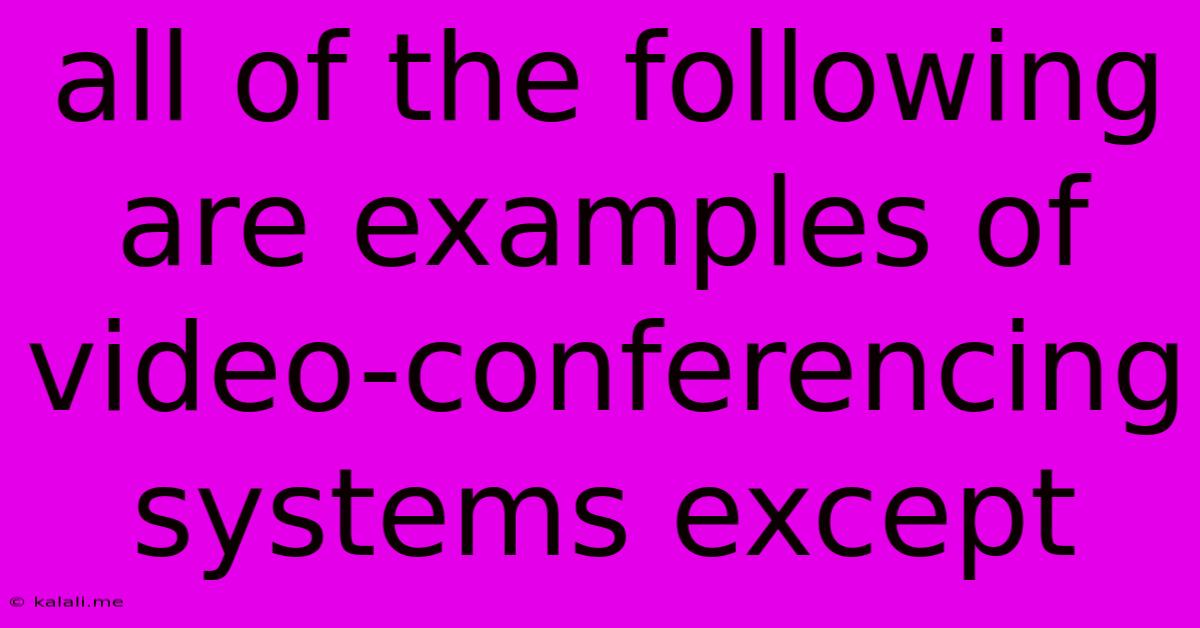All Of The Following Are Examples Of Video-conferencing Systems Except:
Kalali
Jun 14, 2025 · 3 min read

Table of Contents
All of the Following Are Examples of Video Conferencing Systems Except: Identifying the Outsider
Video conferencing has revolutionized communication, allowing individuals and businesses to connect across geographical boundaries in real-time. But with so many platforms available, it's easy to get confused. This article will explore various video conferencing systems and pinpoint the option that doesn't belong. We'll cover the features, strengths, and weaknesses of each, providing a clear understanding of what constitutes a video conferencing system.
What is a Video Conferencing System?
A video conferencing system facilitates real-time, interactive communication between two or more participants, typically using internet connectivity. Key features include audio and video transmission, allowing users to see and hear each other. Many systems also offer screen sharing, chat functionality, and recording capabilities. This technology is crucial for remote work, online education, virtual meetings, and global collaboration.
Examples of Video Conferencing Systems:
Several well-known platforms perfectly fit the definition of a video conferencing system. Let's look at some popular examples:
-
Zoom: Known for its ease of use and widespread adoption, Zoom offers robust features including breakout rooms, cloud recording, and various integration options. It's a leading choice for both personal and professional use.
-
Microsoft Teams: Tightly integrated with the Microsoft Office suite, Teams provides a collaborative workspace combining video conferencing, chat, file sharing, and project management tools. It's a powerful option for businesses already using Microsoft products.
-
Google Meet: Seamlessly integrated with the Google ecosystem, Meet provides a simple and reliable video conferencing solution for individuals and organizations using Google Workspace. Its user-friendly interface and strong security features make it a popular choice.
-
Cisco Webex: A robust platform ideal for large enterprises, Webex offers advanced features like high-definition video, webinar capabilities, and extensive integration options. Its focus on enterprise-grade security and scalability makes it a solid option for large organizations.
The Exception: Identifying the "Non-Video Conferencing" System
While the above examples all facilitate real-time video and audio communication between multiple participants, there are many other software and technologies that serve different purposes. Without knowing the specific options presented in a multiple-choice question, we can't definitively identify the exception. However, consider some possibilities:
-
Email: Email is asynchronous communication; it's not real-time. While you might share visual information (images, videos), it lacks the interactive elements central to video conferencing.
-
Instant Messaging (without video): Text-based chat applications, such as WhatsApp or Facebook Messenger, enable quick communication, but usually lack real-time video and audio capabilities. These facilitate communication, but not video conferencing.
-
Social Media Platforms (primarily): While many social media platforms include video capabilities (e.g., live streaming on Facebook or Instagram), their primary function is not specifically designed for real-time, interactive video conferencing with multiple participants. The focus differs significantly.
-
File Sharing Services: Services like Dropbox or Google Drive enable file transfer and collaboration, but they aren't designed for real-time video communication.
Conclusion:
The key to identifying a non-video conferencing system lies in understanding the core components: real-time, interactive audio and video communication between multiple participants. Any technology lacking these fundamental elements would not be classified as a video conferencing system. Therefore, carefully examine the options presented in any given question to pinpoint the outlier, focusing on the essential features of real-time video communication.
Latest Posts
Latest Posts
-
Which Of The Following Statements Is True About Ions
Jun 15, 2025
-
Who Wrote Sare Jahan Se Achha
Jun 15, 2025
-
Which Solution Is The Most Acidic
Jun 15, 2025
-
How Many Players In A Hockey Game
Jun 15, 2025
-
Is Stainless Steel A Homogeneous Mixture
Jun 15, 2025
Related Post
Thank you for visiting our website which covers about All Of The Following Are Examples Of Video-conferencing Systems Except: . We hope the information provided has been useful to you. Feel free to contact us if you have any questions or need further assistance. See you next time and don't miss to bookmark.